Please click this links to Learn more about some of the services that Pets in Balance Veterinary Care offers. This list is not inclusive of all of our services, so please feel free to inquire if you have questions about services not mentioned here.

Pets in Balance offers house calls for patients that are difficult to travel with due to mobility issues or for those that may have less anxiety in the comfort of their own home than at a veterinary clinic. All of the services that are offered in the clinic can be provided in the home. Please understand that we do not offer comprehensive general practice care, but we are happy to refer you to a veterinarian that can provide those services. If you are interested in a house call, please inquire about additional fees when scheduling your appointment. We kindly ask that you make your pet easily accessible during these appointments and that you inform us of any issues with parking in your area in advance.
 Acupuncture is an excellent treatment for improving imbalances in the body. It has been used in Chinese medicine for over 3,000 years and was introduced in North America in the 1970s. While there are multiples form of acupuncture, the most common one involves the insertion of thin, sterile needles into specific points in the body in order to achieve a therapeutic effect. It is a very safe procedure that is often well tolerated by patients.
Acupuncture is an excellent treatment for improving imbalances in the body. It has been used in Chinese medicine for over 3,000 years and was introduced in North America in the 1970s. While there are multiples form of acupuncture, the most common one involves the insertion of thin, sterile needles into specific points in the body in order to achieve a therapeutic effect. It is a very safe procedure that is often well tolerated by patients.

Acupuncture can be used to treat pain, improve nerve function, increase energy levels and appetite, and to address other medical issues as well. It is often used for patients with arthritis and back problems or neurologic issues secondary to muscle pain, trauma, surgery, spondylosis or intervertebral disc disease.
 The goal of Veterinary Spinal Manipulative Therapy, or chiropractic therapy, is manual treatment of the spine and joints in order to decrease pain and improve biomechanics and range of motion in the spine and limbs. Treatment of areas of segmental spinal dysfunction (or subluxation) results in a neurologic response that helps to restore more normal function in the body. The manipulation also improves muscle and joint function. Patients with primary spinal or back problems causing pain, mobility issues, or incontinence as well as those with secondary spinal dysfunction due to arthritis or lameness often benefit from chiropractic therapy. Many sporting dogs are treated with chiropractic therapy to address muscle strains, stiffness from exercise, or to achieve a competitive edge.
The goal of Veterinary Spinal Manipulative Therapy, or chiropractic therapy, is manual treatment of the spine and joints in order to decrease pain and improve biomechanics and range of motion in the spine and limbs. Treatment of areas of segmental spinal dysfunction (or subluxation) results in a neurologic response that helps to restore more normal function in the body. The manipulation also improves muscle and joint function. Patients with primary spinal or back problems causing pain, mobility issues, or incontinence as well as those with secondary spinal dysfunction due to arthritis or lameness often benefit from chiropractic therapy. Many sporting dogs are treated with chiropractic therapy to address muscle strains, stiffness from exercise, or to achieve a competitive edge.
 Therapeutic laser (also referred to as low level laser therapy) utilizes visible and infrared light to treat pain and inflammation and to promote tissue healing. The light energy is converted into chemical energy to improve cellular function and regeneration. Vasodilation results in improved blood flow and circulation, which flushes out inflammatory mediators and decreases pain and edema. Laser also releases endorphins and decreases scar tissue leading to less pain. Tissue and wound healing are promoted by increased collagen and epithelial formation.Laser is indicated for wound healing, post-operative pain and inflammation, muscle strains, tendon and ligament injuries, degenerative joint disease (arthritis), back pain and for stimulation of acupuncture points in patients that do not tolerate needles. Pets in Balance utilizes a class IV laser. Protective eye wear may be worn by both patients and owners during this therapy. Laser treatments are a wonderful adjunct to some of the other therapies your pet may receive to improve their comfort and mobility.
Therapeutic laser (also referred to as low level laser therapy) utilizes visible and infrared light to treat pain and inflammation and to promote tissue healing. The light energy is converted into chemical energy to improve cellular function and regeneration. Vasodilation results in improved blood flow and circulation, which flushes out inflammatory mediators and decreases pain and edema. Laser also releases endorphins and decreases scar tissue leading to less pain. Tissue and wound healing are promoted by increased collagen and epithelial formation.Laser is indicated for wound healing, post-operative pain and inflammation, muscle strains, tendon and ligament injuries, degenerative joint disease (arthritis), back pain and for stimulation of acupuncture points in patients that do not tolerate needles. Pets in Balance utilizes a class IV laser. Protective eye wear may be worn by both patients and owners during this therapy. Laser treatments are a wonderful adjunct to some of the other therapies your pet may receive to improve their comfort and mobility.
Assistive devices such as a supportive wrap for a dog recovering from an hyperextension injury o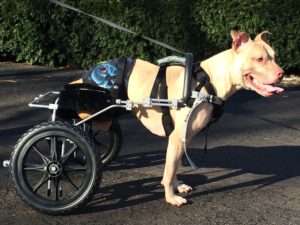 f the carpus, a harness to help lift an older dog struggling to rise from the ground, a cart for a weak or paralyzed dog, a boo
f the carpus, a harness to help lift an older dog struggling to rise from the ground, a cart for a weak or paralyzed dog, a boo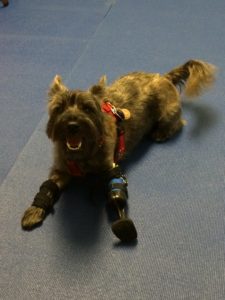 t to help correct and prevent injury from knuckling, or a custom fitted orthotic brace or prosthetic limb are all wonderful tools now available in veterinary medicine to improve patient mobility and quality of life. Dr. Starr has experience in helping owners decide what the best device is to help improve their pet’s mobility.
t to help correct and prevent injury from knuckling, or a custom fitted orthotic brace or prosthetic limb are all wonderful tools now available in veterinary medicine to improve patient mobility and quality of life. Dr. Starr has experience in helping owners decide what the best device is to help improve their pet’s mobility.
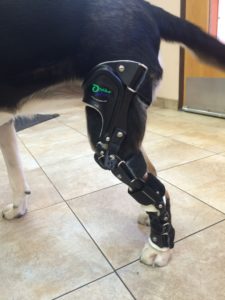 If your pet suffers from mobility issues due to a congenital deformity, is a tripod after a partial amputation due to cancer or a traumatic injury, or has an unstable joint in need of support and is not a good surgical candidate (such as a cranial cruciate ligament tear or Achilles tendon injury), an orthotic or prosthetic device may be a good option for helping to restore more normal biomechanics. Dr. Starr has specialized training and partners with one of the leading providers in the field of veterinary orthotics and prosthetics (V-OP), Orthopets. Schedule an evaluation through either Pets in Balance or Integrative Veterinary Rehabilitation and Sports Medicine of Hanover Park to discuss the options for what assistive devices may be most beneficial for your pet. The process often involves taking measurements or a cast of your pet’s affected limb so that a customized device can be made, followed by an appointment to assess the fit, and further appointments to help acclimate your pet to wearing the device and building strength with physical rehabilitation.
If your pet suffers from mobility issues due to a congenital deformity, is a tripod after a partial amputation due to cancer or a traumatic injury, or has an unstable joint in need of support and is not a good surgical candidate (such as a cranial cruciate ligament tear or Achilles tendon injury), an orthotic or prosthetic device may be a good option for helping to restore more normal biomechanics. Dr. Starr has specialized training and partners with one of the leading providers in the field of veterinary orthotics and prosthetics (V-OP), Orthopets. Schedule an evaluation through either Pets in Balance or Integrative Veterinary Rehabilitation and Sports Medicine of Hanover Park to discuss the options for what assistive devices may be most beneficial for your pet. The process often involves taking measurements or a cast of your pet’s affected limb so that a customized device can be made, followed by an appointment to assess the fit, and further appointments to help acclimate your pet to wearing the device and building strength with physical rehabilitation.
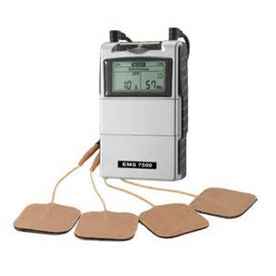 Neuromuscular electrical stimulation (NMES) is the application of an electrical stimulus to a muscle group, which results in a muscle contraction. This treatment can be useful in preventing or treating muscle atrophy that results from lack of weight bearing due to lameness or from poor nerve supply to a muscle group in neurologic injuries. Promoting muscle strengthening is beneficial because the muscles provide shock absorption and support for the joints. Increased muscle mass decreases joint pain and improves mobility in patients. Electrical stimulation is often recommended after surgery when patients have decreased weight bearing on an affected limb or for patients that have neurologic weakness and need more strength to rise and walk. Electrical stimulation works nicely in combination with a home exercise program to improve patient mobility. Patients are often shaved where the electrodes will be applied to achieve better conduction to the muscle group and stronger contractions.
Neuromuscular electrical stimulation (NMES) is the application of an electrical stimulus to a muscle group, which results in a muscle contraction. This treatment can be useful in preventing or treating muscle atrophy that results from lack of weight bearing due to lameness or from poor nerve supply to a muscle group in neurologic injuries. Promoting muscle strengthening is beneficial because the muscles provide shock absorption and support for the joints. Increased muscle mass decreases joint pain and improves mobility in patients. Electrical stimulation is often recommended after surgery when patients have decreased weight bearing on an affected limb or for patients that have neurologic weakness and need more strength to rise and walk. Electrical stimulation works nicely in combination with a home exercise program to improve patient mobility. Patients are often shaved where the electrodes will be applied to achieve better conduction to the muscle group and stronger contractions.
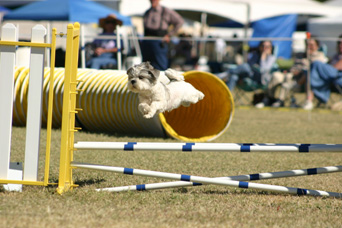 Your veterinarian at Pets in Balance will develop a home exercise program for your pet aimed at improving function, strength, and mobility. The exercise program is geared at being therapeutic for those areas in which your pet struggles to have normal comfort, range of motion, strength, gait and mobility.
Your veterinarian at Pets in Balance will develop a home exercise program for your pet aimed at improving function, strength, and mobility. The exercise program is geared at being therapeutic for those areas in which your pet struggles to have normal comfort, range of motion, strength, gait and mobility. 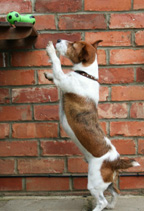 Exercise equipment such as cavaletti poles, weave cones, balance discs, and hills or stairs are often employed to target these goals. Neurologic patients often need to improve proprioception, or awareness of where their body is in space, in addition to balance and strength while an arthritic patient may need to improve strength and active range of motion. Exercises will be prescribed with a recommended frequency and duration with periodic rechecks throughout your pet’s therapy program. Guided and controlled exercise programs can make a significant difference in your pet’s mobility and quality of life. Exercise programs often pair well with other home therapies such as massage, passive range of motion, and hot or cold therapy.
Exercise equipment such as cavaletti poles, weave cones, balance discs, and hills or stairs are often employed to target these goals. Neurologic patients often need to improve proprioception, or awareness of where their body is in space, in addition to balance and strength while an arthritic patient may need to improve strength and active range of motion. Exercises will be prescribed with a recommended frequency and duration with periodic rechecks throughout your pet’s therapy program. Guided and controlled exercise programs can make a significant difference in your pet’s mobility and quality of life. Exercise programs often pair well with other home therapies such as massage, passive range of motion, and hot or cold therapy. 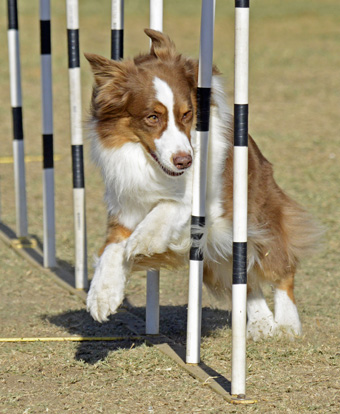 Many owners of canine athletes pursue exercise consultations to work on targeted strengthening so they can improve their pet’s performance in the agility ring or when tracking in the field, among other sports.
Many owners of canine athletes pursue exercise consultations to work on targeted strengthening so they can improve their pet’s performance in the agility ring or when tracking in the field, among other sports.
 Massage therapy is a manual therapy with the goal of improving circulation, achieving muscle relaxation, relieving pain, and sometimes anxiety in patients. It is useful for injury prevention in sporting dogs and for addressing muscle restrictions and pain in dogs with more chronic conditions such as arthritis or hind limb weakness.
Massage therapy is a manual therapy with the goal of improving circulation, achieving muscle relaxation, relieving pain, and sometimes anxiety in patients. It is useful for injury prevention in sporting dogs and for addressing muscle restrictions and pain in dogs with more chronic conditions such as arthritis or hind limb weakness.
Massage therapy often pairs well with passive range of motion. Your veterinarian at Pets in Balance is trained in diagnosing muscle dysfunction and can both treat your pet and train you on how to address muscle issues at home.

 Passive range of motion is utilized to improve joint flexibility and range of motion. Restricted range of motion leads to stiffness, pain, and lameness and is often an issue after surgery, in arthritic patients, or after injury. Improving joint flexibility can improve patient comfort and mobility. We are happy to train you in how to do proper range of motion and stretching at home and often will combine this modality with other therapies such as laser or massage when we are treating patients.
Passive range of motion is utilized to improve joint flexibility and range of motion. Restricted range of motion leads to stiffness, pain, and lameness and is often an issue after surgery, in arthritic patients, or after injury. Improving joint flexibility can improve patient comfort and mobility. We are happy to train you in how to do proper range of motion and stretching at home and often will combine this modality with other therapies such as laser or massage when we are treating patients.